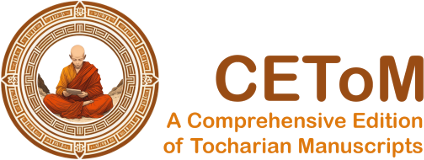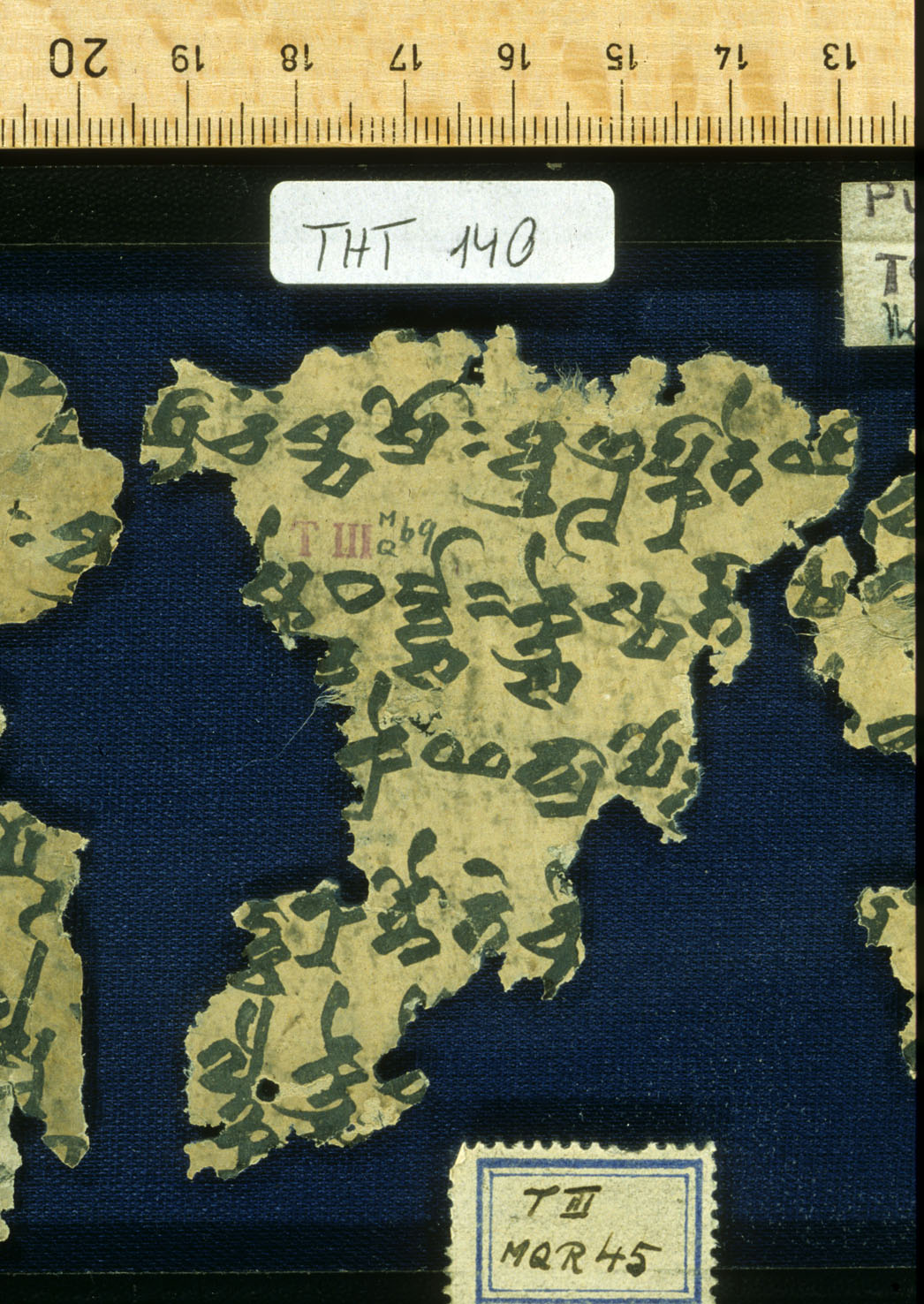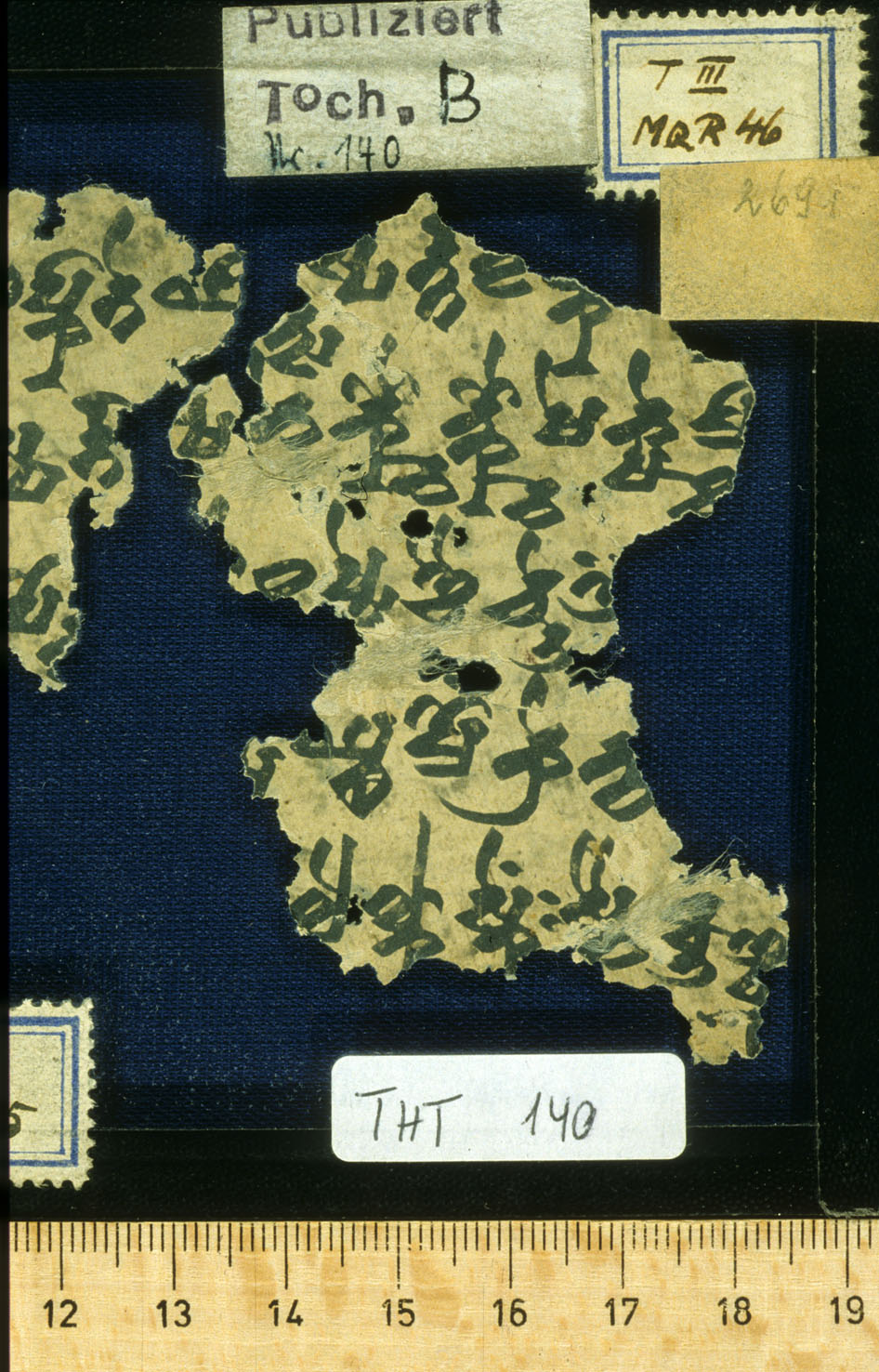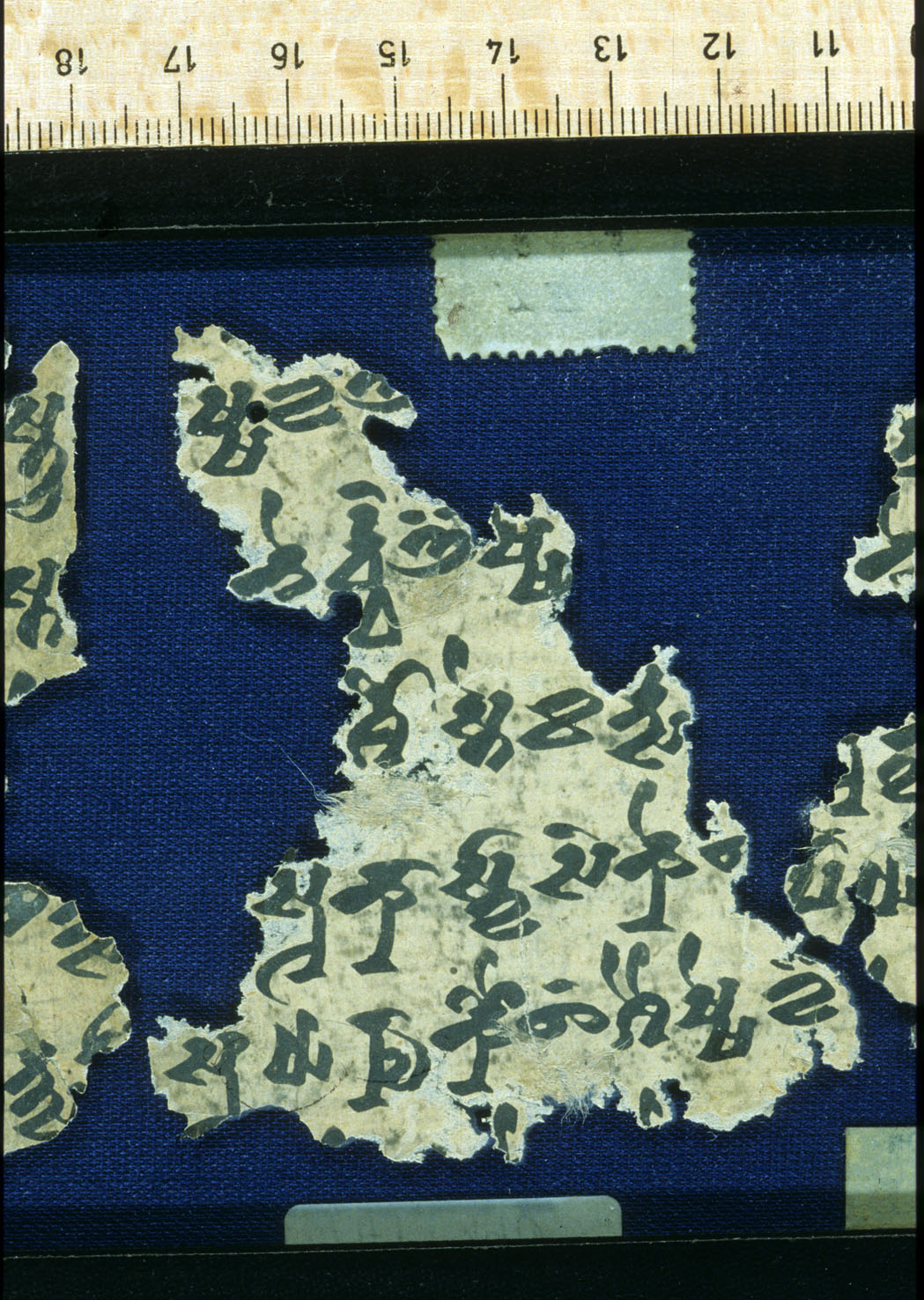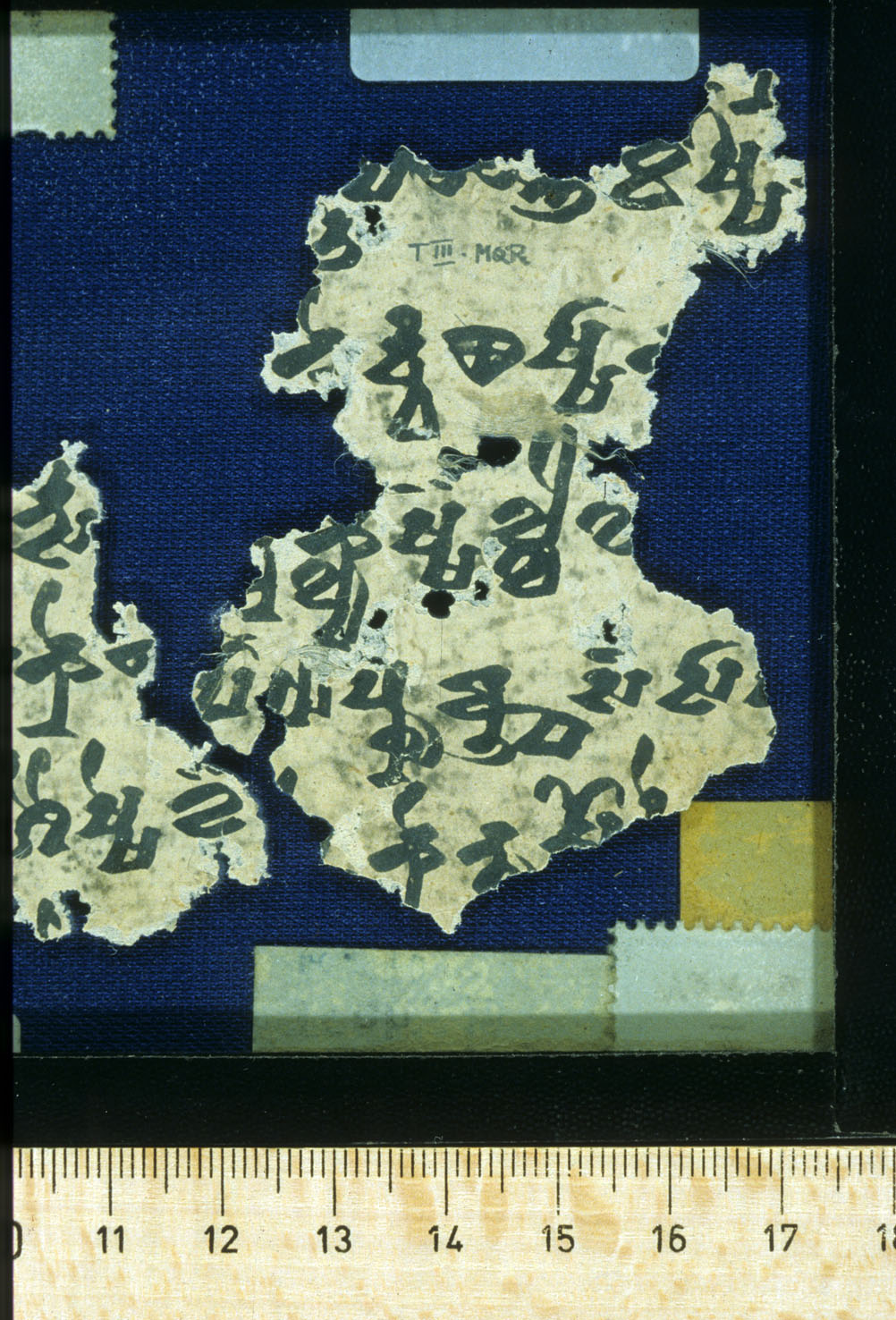THT 140
| Known as: | THT 140; Bleistiftnummer 2691 |
|---|---|
| Cite this page as: | "THT 140". In A Comprehensive Edition of Tocharian Manuscripts (CEToM). Created and maintained by Melanie Malzahn, Martin Braun, Hannes A. Fellner, and Bernhard Koller. https://cetom.univie.ac.at/?m-tht140 (accessed 13 Jul. 2025). |
Provenience | |
| Main find spot: | Kizil Ming-öy |
| Specific find spot: | Rothkuppelraum |
| Expedition code: | T III MQR 46, T III MQR 45 (on the frame), T III MQ 69 (on the fragment) |
| Collection: | Berlin Turfan Collection |
Language and Script | |
| Language: | TB |
| Linguistic stage: | archaic |
| Script: | archaic |
Text contents | |
| Text genre: | Literary |
| Text subgenre: | Kāvya |
| Verse/Prose: | verse |
Object | |
| Manuscript: | THT 133-147 |
| Material: | ink on paper |
| Form: | Poṭhī |
| Number of lines: | 6 |
Images
Images from idp.bl.uk by courtesy of the International Dunhuang Project, the Berlin-Brandenburgische Akademie der Wissenschaften, and the Staatsbibliothek zu Berlin – Orientabteilung.
Transliteration
| a1 | /// ··ts· sp· rtt· w· ·k· /// |
|---|---|
| a2 | /// [ṣ]ṣ· n[e] kau¯ ¯n nkau¯ ¯n ṣe kṣe¯ ¯k mā /// /// y[rā] cä mpa mo : ā ñū pkā te yā /// |
| a3 | /// ·[au] ta ṣṣe ñcai ce¯ ¯u ñä /// /// ske¯ ¯u ta ṅwsā : kuse spa rtā /// |
| a4 | /// ·[ṣ]· yna moṃ kre nta /// /// kle śa nmā po /// |
| a5 | /// le lkā skeṃ : snai ā[¯] [¯]ñ[m] /// /// ṅka k· tnau taṃ c[vi] /// |
| a6 | /// ltke kuse [cai] /// |
| b1 | /// u[p]· s̝a¯ ¯ñ ka ṣṣi[ṃ] /// /// ṣṣa w· ñ· /// |
| b2 | /// ne rvva na ṣṣā /// /// ne rvvaṃ ñä ṣṣ[e] /// |
| b3 | /// ·[ū] kly· – ṣṣä lle [o]· /// /// rśo ste ka [r]ts· /// |
| b4 | /// p[ā] 10 4 ā¯ ¯p saṃ sā /// /// sū kā swā saṃ ke s̝a /// |
| b5 | /// k·e nt[ya] mo r·e /// /// sū 10 5 kau s̝a mśai ṣṣe wä /// |
| b6 | /// |
Transcription
| a1 | /// ··ts· sp· rtt· w· ·k· /// |
|---|---|
| a2 | /// ṣṣ· ne kaunn kaun ṣek-ṣek mā /// /// y rā cämpämo : āñū pkāte yā /// |
| a3 | /// (n)autäṣṣeñcai ceu ñä /// /// skeu täṅwsā : kuse spärtā /// |
| a4 | /// ·ṣ· ynämoṃ krentä /// /// kleśänmā po /// |
| a5 | /// le lkāskeṃ : snai āñm /// /// ṅk{†ä} k(e)t nautaṃ cvi /// |
| a6 | /// ltke kuse cai /// |
| b1 | /// u p(o) ṣäñ käṣṣiṃ /// /// ṣṣa w· ñ· /// |
| b2 | /// nervvanäṣṣ= ā /// /// nervvaṃ ñäṣṣe /// |
| b3 | /// ·ū kly(eu)ṣṣälle o· /// /// rśo ste kärts· /// |
| b4 | /// pā 10-4 āp saṃsā /// /// sū kā swāsaṃ ke ṣä /// |
| b5 | /// k(r)ent yamor·e /// /// sū 10-5 kauṣäm śaiṣṣe wä /// |
| b6 | /// |
Commentary
Remarks
| The two fragments of THT 140 are in one frame with THT 135,2. |
Alternative linguistic/paleographic classifications
| Peyrot 2008 | A1 |
| Malzahn 2007a | A4 |
| Tamai 2011 | A2 |
| Tamai 2011 | C14 |
References
Online access
Edition
Sieg and Siegling 1953: 72-73
Translations
Carling 2000: a2 (298); Thomas 1957: a3 (229)
Bibliography
Carling, Gerd. 2000. Die Funktion der lokalen Kasus im Tocharischen. Berlin/New York: de Gruyter.
“The International Dunhuang Project: The Silk Road Online.” n.d. http://idp.bl.uk.
Malzahn, Melanie. 2007a. “The most archaic manuscripts of Tocharian B and the varieties of the Tocharian B language.” In Instrumenta Tocharica, edited by Melanie Malzahn, 255–97. Heidelberg: Winter.
Peyrot, Michaël. 2008. Variation and change in Tocharian B. Vol. 15. Leiden Studies in Indo-European. Amsterdam/New York: Rodopi.
Sieg, Emil, and Wilhelm Siegling. 1953. Tocharische Sprachreste. Sprache B, Heft 2. Fragmente Nr. 71-633. Edited by Werner Thomas. Göttingen: Vandenhoeck & Ruprecht.
Tamai, Tatsushi. 2011. Paläographische Untersuchungen zum B-Tocharischen. Innsbrucker Beiträge zur Sprachwissenschaft 138. Innsbruck: Institut für Sprachen und Literaturen.
Thomas, Werner. 1957. Der Gebrauch der Vergangenheitstempora im Tocharischen. Wiesbaden: Harrassowitz.
Gippert, Jost, Katharina Kupfer, Christiane Schaefer, and Tatsushi Tamai. n.d. “Thesaurus Indogermanischer Text- und Sprachmaterialien (TITUS): Tocharian Manuscripts from the Berlin Turfan Collection.” http://titus.fkidg1.uni-frankfurt.de/texte/tocharic/thtframe.htm.
